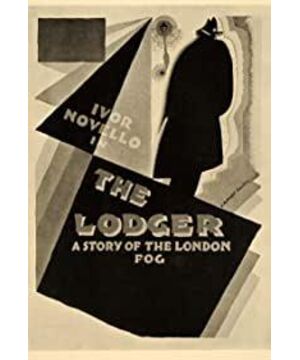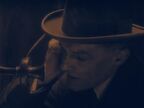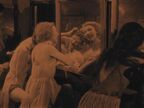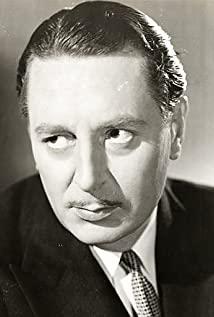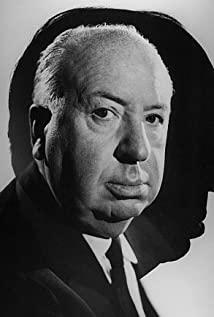The handsome tenant, as expected, let the beautiful landlord daughter who was in love with the beautiful landlord's daughter empathize with each other. Hitchcock uses contrast to express the transfer of love: upstairs, she and the tenant play elegant chess in a romantic and warm atmosphere. But after the police boyfriend arrived, the game suddenly changed to handcuffs. Not to mention being rude, it hurts my wrist. However, it should be noted that there is no difference between the national elephant and the handcuffs in promoting the interaction between the sexes. The root of the problem lies with the policeman. It was him who moved the show that should have been passionately staged on the bed after marriage to the rehearsal time during the marriage proposal time. Naturally, it backfired.
Hitchcock's early films often featured roles in which the girl's boyfriend was a police officer (Blackmail, The Tenant) or the man's girlfriend was the police chief's daughter (The Young Girl). This arrangement is a double-edged sword. On the one hand, of course, it allows the police character to participate in the storyline as early as possible and pose some kind of potential threat to the innocent protagonist. But on the other hand, no matter how much you fear and hate them, the work of the police is still upholding the rule of law and social stability. Therefore, the threats they can create are extremely limited, and it is impossible to bring life worries to the parties involved. This may explain why in Hitchcock's most famous early works "The Thirty-Nine Steps" and "The Lady Disappears", as well as many works in the middle and later stages, the "negative characters" played by the police were all considered by foreign spy agents or perverts. Murderer replaced.
As the story continues, the girl gets more solitude for the tenant. Her blond hair, as well as scissors, pokers and other props, have become tools for creating tension and suspense. But Hitchcock apparently ignored the psychological effects of "the wolf is coming". There are too many suspenseful settings, and they are mostly focused on the tenant and the girl, which instead gives the audience the feeling of being a mystery. Especially after the real identity of the tenant is exposed, this feeling is particularly strong: if you want to avenge your relatives, you should go to it. At the end of the film, when the police came to search the house, the tenant's reaction took this "unreasonable head" to the extreme: since the person in the photo is your sister, just go to the police station to cooperate with the investigation and rule out the suspicion. Why run away? The paradox also appears in the landlady. A month's rent in advance made it so favorable to the new tenant that when police asked her if it was safe to be with the tenant out of concern for her daughter, she swore, "He's not that kind of guy." But the same old lady was spying on the tenant who sneaked out without warning, as if she had suspected him for a long time.
Although Hitchcock has experienced the silent film era and often talks about the concept of "Pure Cinema" in interviews, he personally thinks that his silent film standard is not very high. In addition to the above-mentioned plot that is not rigorous enough, and the techniques are not as skilled and professional as in the American period, the lack of the iconic comedy style is also one of the important reasons. British comedy is generally a comedy with verbal humor at its core, but silent films just don't provide a voice. So Hitchcock couldn't express his dark humor through the dialogue of the characters in the film. And imagine, in the era of sound films, the police officers in this film would certainly not be so rigid and rigid, and the landlord and his wife would likely be transformed into two vivid comedy images.
Finally, let's talk about Hitchcock's stunt shots. Baraz's "Aesthetics of Cinema" gives an example of the narrative function of sound in the age of silent films: a Russian film in which a band suddenly plays a folk song at a high-class ball, causing a commotion among the dignitaries. Here, the composition has a narrative function, it is what triggers changes in the listener's behavior. But since this is a silent film, the audience cannot hear the sound, so they cannot understand why there is an uproar at the scene... In short, such a plot is not suitable for silent films. In my opinion, the most famous scene in the film, which uses feet walking back and forth on a transparent floor to represent the rapid pacing, falls into this category. Yes, you can find other ways to indirectly convey the same message, but no matter what you do, it is better to let the audience hear the pacing directly. Just like the subtitle cards in a silent film, no matter how fancy you do it, it's better to let the audience hear the actor's dialogue in sync. In this sense, Hitchcock's "replacing voice with pictures" is very imaginative, but it has little substantial contribution to improving the quality of the film. Also, the shaking of the ceiling chandelier in front of this shot is not realistic enough. Usually, no matter how restless a person is, his pacing cannot make the chandelier downstairs tremble. Only Astaire's callioch can make such a big movement.
View more about The Lodger: A Story of the London Fog reviews


